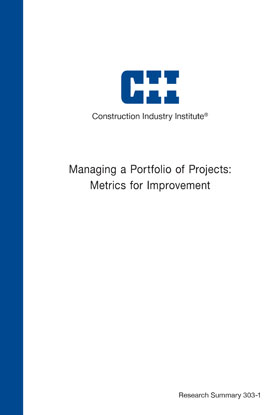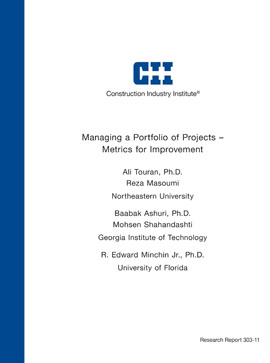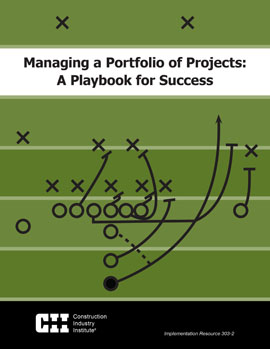
Managing a Portfolio of Projects: Metrics for Improvement
CII chartered Research Team (RT) 303, Managing a Portfolio of Projects: Metrics for Improvement, to answer the following essential research question:
Which practices, techniques, technology, and processes are most effective for managing a portfolio of projects?
The research team defined a portfolio as a group of related or unrelated projects and/or programs managed by a single individual, the portfolio manager. (It may be noteworthy that the Project Management Institute (PMI) definition of the term focuses more on the link between portfolio creation and the achievement of business goals.) Using both quantitative and qualitative, the team took a five-phase approach to its investigation of resource, financial, and risk management, and portfolio metrics:
- Literature review
- Design and performance of a fact-finding survey
- Structured interviews
- Analysis of interview findings
- Research summary and conclusions
The survey results showed that most organizations assign individuals with both technical/business expertise and strong managerial skills to manage multiple projects. Firms most commonly use portfolio management processes to maintain consistency and create standard processes. They also use these processes to control overall budgets, meet clients’ specific requirements, group similar projects, effectively manage resources, meet organizational goals, and prioritize projects. Most firms have consistent internal portfolio processes, but adopt external processes to match their client’s needs. Some firms use aspects of CII processes such as front end planning and the Project Definition Rating Index. While several firms roll project data up to the portfolio level, the data transfer between systems is mostly manual. Portfolio management software packages used by the survey participants ranged from internally developed to large-scale, third-party packages. None of the participants had an integrated system for gathering information into one database and automatically creating portfolio reports.
All firms interviewed used some sort of metric to measure portfolio success, with most using a traffic-light indicator dashboard (i.e., with green, yellow, and red color-coding). The most common areas measured are safety, number of change orders, return on investment, planned versus actual cost, cash flow, planned versus actual schedule, and number of issues/concerns. As part of their continuous improvement efforts, firms use portfolio management best practices for lessons learned, schedule, cost, procurement, resource allocation, communication, scope, change management, safety, risk management, and issue management. The team found that lessons learned dissemination across the portfolio is important for effective management, with schedule, cost, and resource allocation cited as key areas.
Barriers to effective implementation of portfolio management included resistance to change and a lack of alignment, consistency, and commitment at the top management levels. Key improvements identified to overcome these barriers include data integration and interoperability, standardization across projects, quantitative metrics, improved resource forecasting, and automated dashboards.
To help portfolio managers implement effective portfolio management practices, the team developed Implementation Resource (IR) 303-2, Managing a Portfolio of Projects: A Playbook for Success. This publication helps users identify, adapt, develop, and recommend practices for portfolio management, specifically in the areas of resource management, financial management, risk management, and portfolio metrics. This resource includes a portfolio management system example and chapters on the following topics:
- Portfolio formation strategies
- Portfolio management
- Recommended process for portfolio performance management
- Recommended practices for portfolio management.



